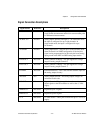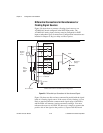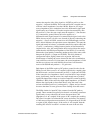
Chapter 2 Configuration and Installation
AT-MIO-16X User Manual 2-22
©
National Instruments Corporation
Table 2-5 summarizes the recommended input configuration for both
types of signal sources.
Differential Connection Considerations
(DIFF Input Configuration)
Differential connections are those in which each AT-MIO-16X analog
input signal has its own reference signal or signal return path. These
connections are available when the AT-MIO-16X is configured in the
DIFF input mode. Each input signal is tied to the positive (+) input of
the PGIA; and its reference signal, or return, is tied to the negative (–)
input of the PGIA.
When the AT-MIO-16X is configured for differential input, each signal
uses two multiplexer inputs—one for the signal and one for its reference
signal. Therefore, with a differential configuration, up to eight analog
input channels are available. Differential input connections should be
used when any of the following conditions are present:
• You are connecting eight or fewer signals to the AT-MIO-16X.
• Input signals are low level (less than 1 V).
• Leads connecting the signals to the AT-MIO-16X are greater than
10 ft.
• Any of the input signals require a separate ground-reference point
or return signal.
• The signal leads travel through noisy environments.
Differential signal connections reduce picked-up noise and increase
common-mode noise rejection. Differential signal connections also
permit input signals to float within the common-mode limits of the
PGIA.
Table 2-5.
Recommended Input Configurations for Ground-Referenced and
Floating Signal Sources
Type of Signal Recommended Input
Configuration
Ground-referenced (nonisolated outputs,
plug-in instruments)
DIFF
NRSE
Floating (batteries, thermocouples, isolated
outputs)
DIFF with bias resistors
RSE


















